To build muscle with CrossFit, prioritize strength training with compound movements like squats and deadlifts. Increase your protein intake to 1.6-2.2 grams per kg of body weight daily, and optimize rest with 7-9 hours of sleep nightly. Focus on progressive overload by gradually increasing weight or reps. Adjust workout volume, monitor cardio intensity, and tailor your nutrition to support muscle growth. Track your progress consistently to guarantee you're making gains. Remember to include Olympic lifts and stick with multi-joint exercises in every workout. By following these tips, you'll be well on your way to achieving your muscle-building goals through CrossFit.
Core Insight
- Prioritize strength training with compound exercises like squats and deadlifts 2-3 times weekly.
- Increase protein intake to 1.6-2.2 grams per kg of body weight daily for muscle growth.
- Optimize rest and recovery with 7-9 hours of sleep and light activities on rest days.
- Focus on progressive overload by gradually increasing weight, frequency, or repetitions in workouts.
- Include Olympic lifts and multi-joint movements in every CrossFit workout for maximum muscle engagement.
Prioritize Strength Training
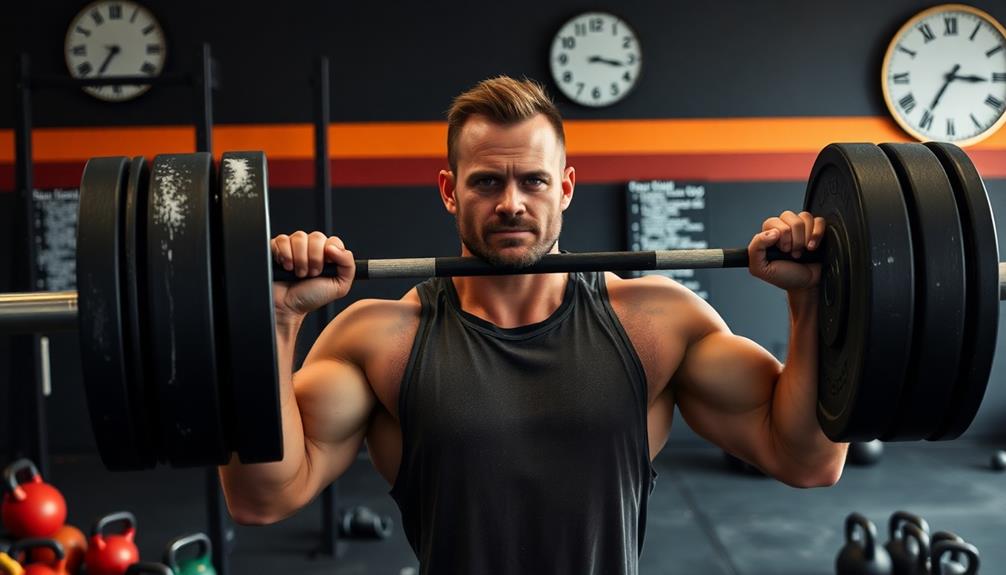
To build muscle with CrossFit, focus on strength training first. Do exercises that work many muscles at once, like squats and deadlifts. These help you gain muscle better than exercises for only one muscle. Think about using supplements with ingredients like HMB to help you get stronger and recover.
Do strength workouts 2-3 times a week. Use heavy weights and do 3-5 reps to build strength and muscle. Always use good form to avoid injuries and get the most out of your workouts.
As you get stronger, slowly add more weight or reps. This challenges your muscles to keep growing. The key is to stick with it, even on days when you don't feel like it.
Increase Protein Intake
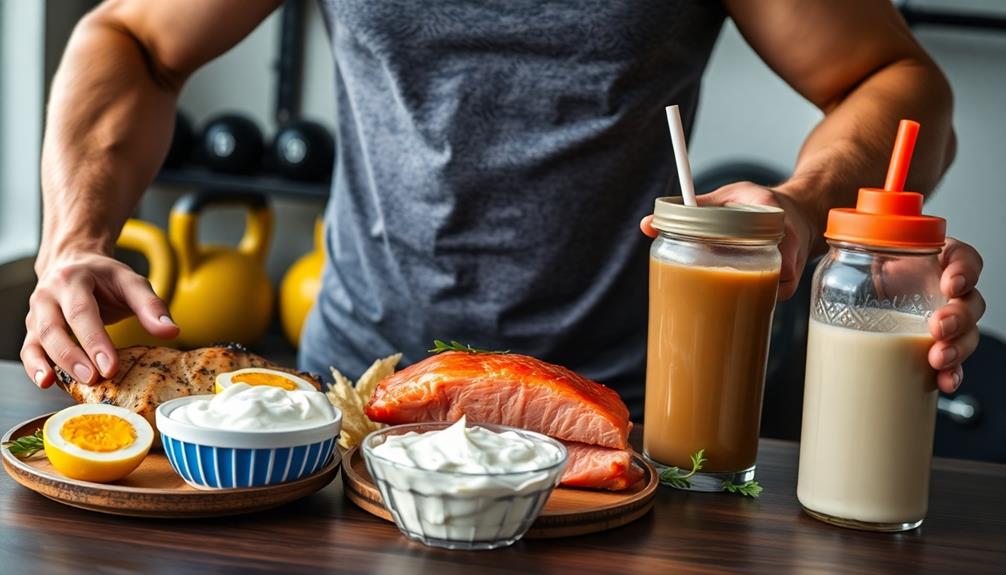
Eating more protein is crucial for building muscle when you do CrossFit. Aim to get 1.6 to 2.2 grams of protein per kilogram of your body weight each day. It's best to eat protein at every meal and snack.
Here are some foods that are high in protein:
- Chicken breast: 31 grams of protein and 165 calories per 100 grams
- Greek yogurt: 10 grams of protein and 59 calories per 100 grams
- Eggs: 13 grams of protein and 155 calories per 100 grams
- Lentils: 9 grams of protein and 116 calories per 100 grams
If you can't get enough protein from food, think about using a protein powder supplement. Whey protein is a good choice because your body absorbs it quickly. It's perfect for after your workout.
Don't forget to drink plenty of water. You should also eat enough carbs and healthy fats to fuel your workouts and recover well.
Optimize Rest and Recovery

Rest and recovery are key for building muscle through CrossFit. Balance intense workouts with enough downtime. Get 7-9 hours of sleep each night so your body can repair and grow muscle. On rest days, do light activities like jogging, swimming, or yoga to improve blood flow and reduce soreness. Foam rolling can also help with circulation and recovery between workouts.
Don't skip rest days – they prevent overtraining and injury. Adjust your training schedule based on how you feel. Use foam rolling and stretching to help your muscles recover and stay flexible. Eat enough protein and carbs during recovery to refuel and support muscle growth. Remember, muscles grow during rest, not during workouts.
Focus on Compound Movements
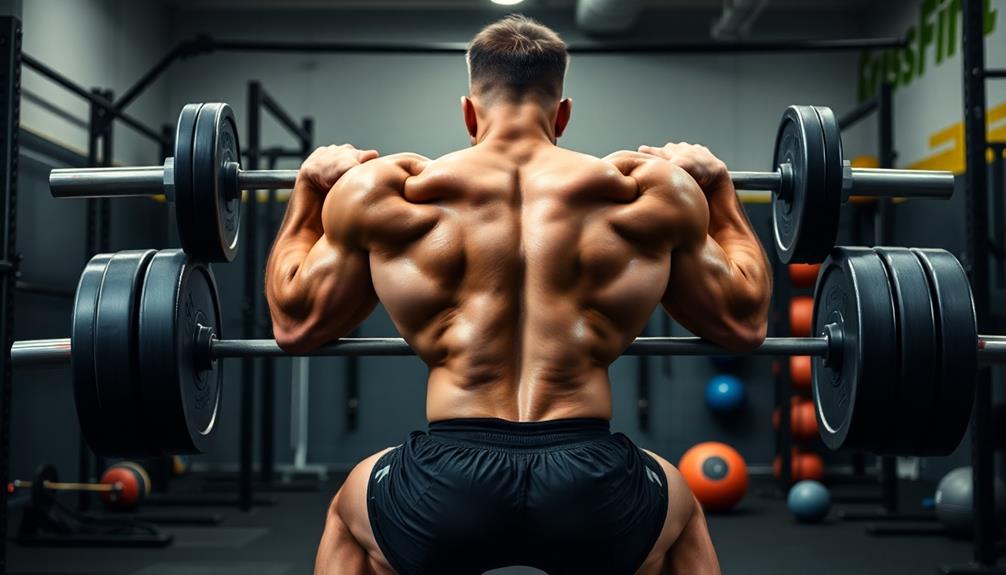
Compound exercises are the foundation of building muscle with CrossFit. They work several muscles at once, making your workouts efficient and helping you gain strength all over. Zero in on key compound lifts: squats, deadlifts, bench presses, and overhead presses. Master these with good form before using heavy weights. Mix in different versions to work various muscle fibers and keep progress steady.
Olympic lifts like clean and jerks or snatches are also important. They build strength plus power and coordination. Stick with it! Do compound exercises each CrossFit workout and rest enough between sessions. This focus on multi-joint movements will drive muscle growth and take your fitness to the next level.
Progressive Overload
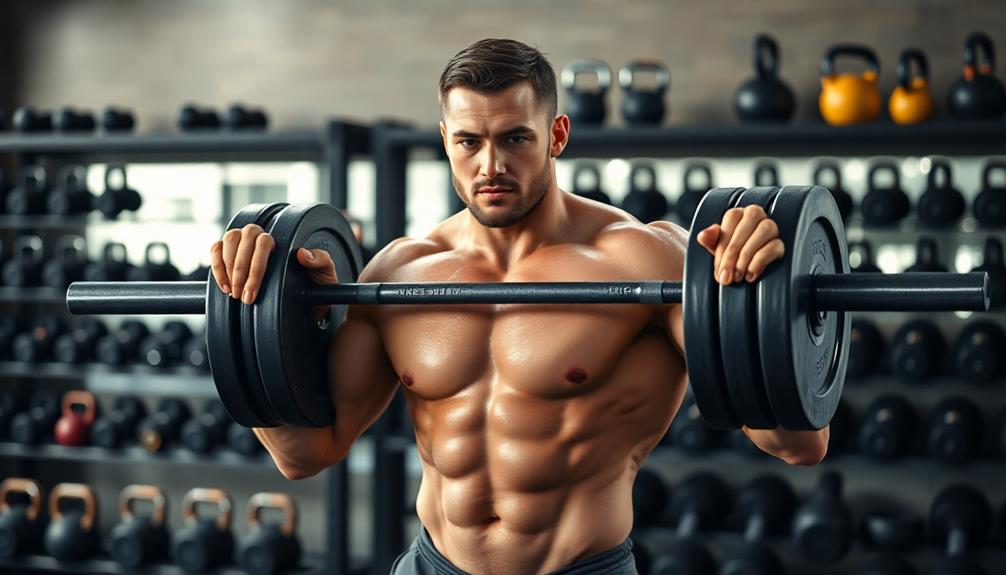
Progressive overload is the key to building muscle with CrossFit. It means gradually increasing the amount of weight you lift, how often you lift, or the number of times you repeat each lift. To do this, you need to regularly challenge your muscles by adding weight or reps to your workouts. Progressive overload is like choosing the best protein blend for muscle support – it takes some thought and planning based on your abilities and goals.
Start by keeping a record of your lifts and metcons. Each week, try to lift a bit more weight or do a couple more reps than you did the week before. Take it slow and steady. Small increases every week add up over time. For example, when doing back squats, add about 5 pounds to the weight every week or two.
Supplement Wisely
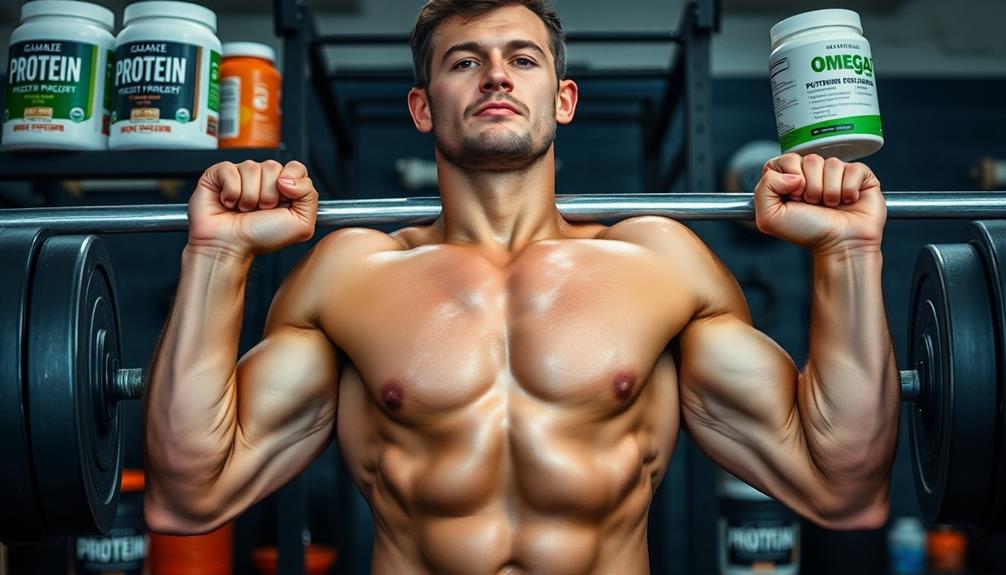
Supplements support muscle growth along with your CrossFit workouts. You don't need many supplements – just focus on a few key ones:
- Protein powder: Helps you get enough protein to build and repair muscle.
- Creatine: Improves muscle strength and power during intense workouts.
- BCAAs: Help muscles recover and reduce tiredness during exercise.
- Fish oil: Provides healthy omega-3 fats that may help with muscle growth.
Choosing supplements can be tricky. For creatine, look for trusted brands with pure, tested products to ensure it works well.
Adjust Workout Volume
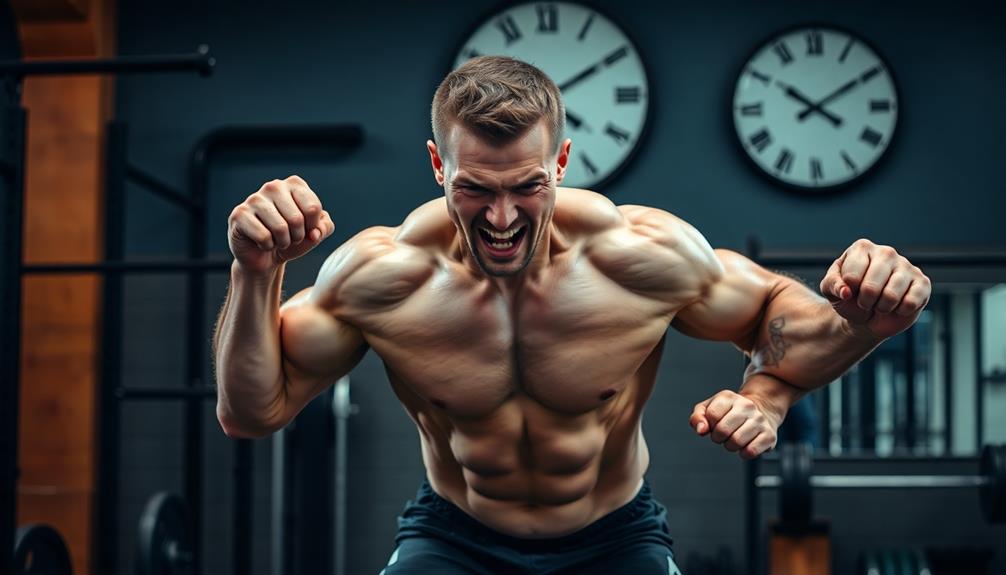
Adjusting workout volume is key for building muscle with CrossFit. CrossFit is great for conditioning, but you'll need to change your approach to gain serious muscle. Add extra sets or reps to exercises that build muscle, like squats, deadlifts, and presses. These compound movements work several muscles at once. Resistance bands can make your workouts more challenging, especially for pull-ups or assisted squats.
Pay attention to recovery as you increase volume. You may need to do fewer intense WODs so your muscles can repair and grow. Trust your body and make changes as needed.
- Get out of your comfort zone
- Take on the challenge of lifting heavier
- Picture your muscles getting stronger every rep
Monitor Cardio Intensity
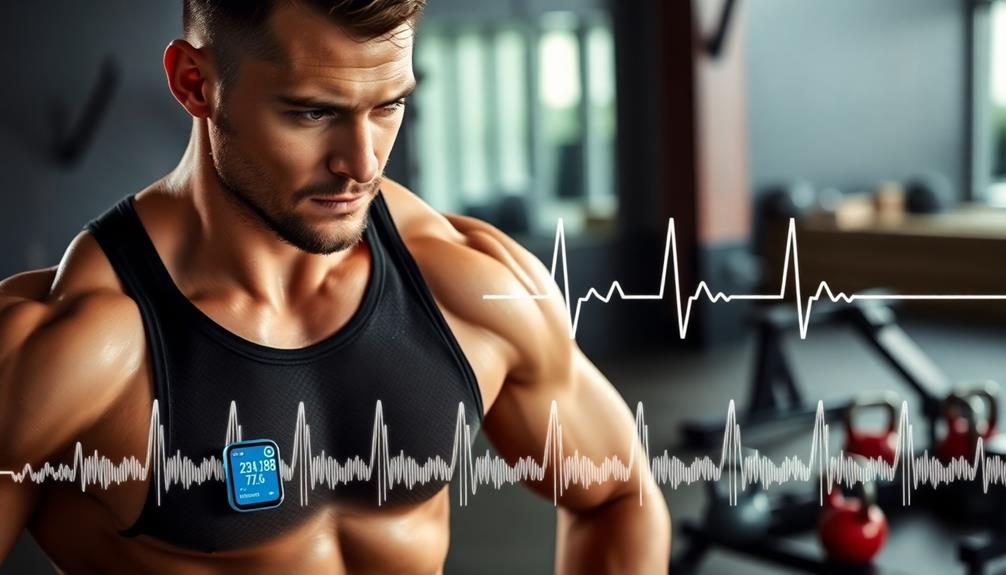
Monitoring your cardio intensity is crucial as you increase your CrossFit training. High-intensity workouts are a staple of CrossFit, but overdoing cardio can limit muscle growth. Strike a balance to build strength and maintain heart health. Stay hydrated during intense sessions, possibly with electrolyte drinks to aid muscle recovery.
Heart rate monitors help track effort during workouts. Keep your heart rate at 70-85% of your max most of the time. This builds muscle while benefiting your cardiovascular system.
To focus on muscle gains, cap high-intensity cardio at 2-3 weekly sessions. Other days, focus on strength exercises and low-intensity cardio. Don't overdo cardio, as rest is key for muscle development. By tracking and managing cardio intensity, you'll optimize your CrossFit training for muscle growth.
Tailor Nutrition to Goals
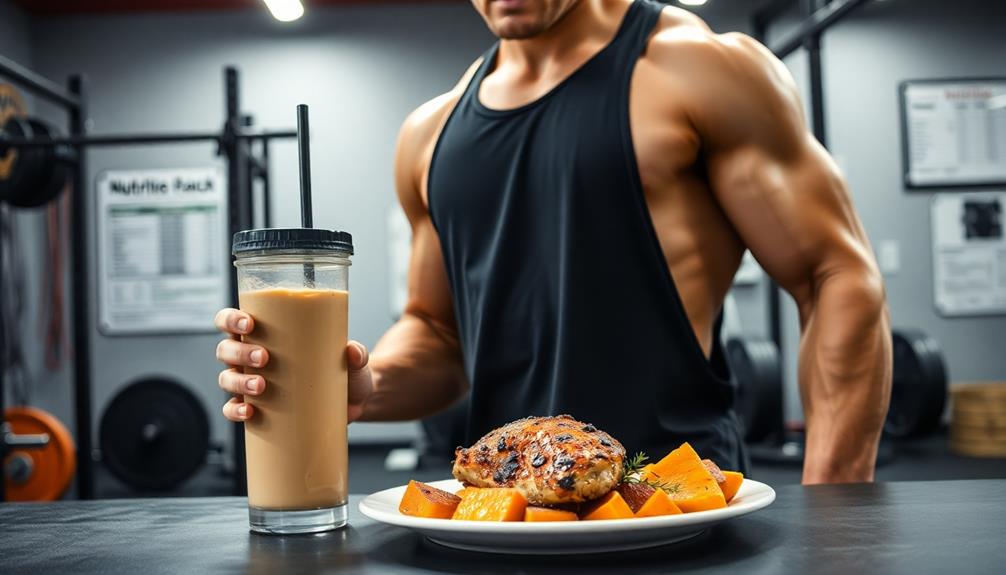
Eating right is key for building muscle with CrossFit. To get the best results, you need to match your diet to your goals. Boost your protein to about 1.6-2.2 grams per kilogram of body weight. This gives your muscles what they need to recover and grow. Protein powders can help you reach your protein targets and build lean muscle. Look for powders with 20-30g of protein per serving and complete amino acids.
Don't skip carbs and healthy fats – they're important for energy and hormones. Eat a balanced meal with protein, carbs, and fats within 30 minutes after your workout. This jump-starts recovery.
- Eat whole foods packed with nutrients
- Drink plenty of water for muscle function and recovery
- Think about supplements like creatine for extra muscle gains
Track Progress Consistently

To build muscle effectively, you need to track your progress consistently. Don't rely on feelings alone. Keep a workout log and write down your exercises, weights, reps, and sets. This helps you spot patterns and ensure you're continuously challenging yourself. Foam rolling can aid in recovery and reduce soreness after tough CrossFit workouts.
Measure your body regularly, focusing on key muscle groups like your chest, arms, and thighs. Take photos to visually track changes. Check your body weight weekly, but remember that muscle gains might not always show up on the scale.
Test your strength periodically by finding your one-rep max or doing benchmark workouts. Notice how your clothes fit and your overall energy levels. By tracking these different metrics consistently, you'll gain valuable insights into your muscle-building progress and stay motivated to achieve your goals.
Frequently Asked Questions
How Long Does It Typically Take to See Noticeable Muscle Gains With Crossfit?
You'll typically notice initial muscle gains within 4-8 weeks of consistent CrossFit training. However, significant muscle growth can take 3-6 months or longer, depending on your diet, genetics, and workout intensity. Stay patient and keep pushing yourself.
Can Women Build Significant Muscle Mass Through Crossfit Training?
Yes, you can build significant muscle mass through CrossFit as a woman. Your body produces testosterone and growth hormone, allowing for muscle development. Consistent training, proper nutrition, and progressive overload will help you achieve noticeable gains over time.
Is It Necessary to Follow a Specific Crossfit Program for Muscle Building?
While a specific CrossFit program isn't necessary for muscle building, it can be beneficial. You'll see better results if you focus on compound exercises, progressive overload, and proper nutrition. Don't forget to tailor your workouts to your goals.
How Does Crossfit Compare to Bodybuilding for Muscle Growth?
You'll find CrossFit and bodybuilding both build muscle, but they differ in approach. CrossFit focuses on functional fitness and varied workouts, while bodybuilding targets specific muscle groups. Your goals and preferences should guide your choice between them.
Are There Age Limitations for Building Muscle Effectively With Crossfit?
You're never too old to build muscle with CrossFit. While younger folks may see faster gains, you can still make significant progress at any age. Just listen to your body, adapt workouts as needed, and maintain consistency.

